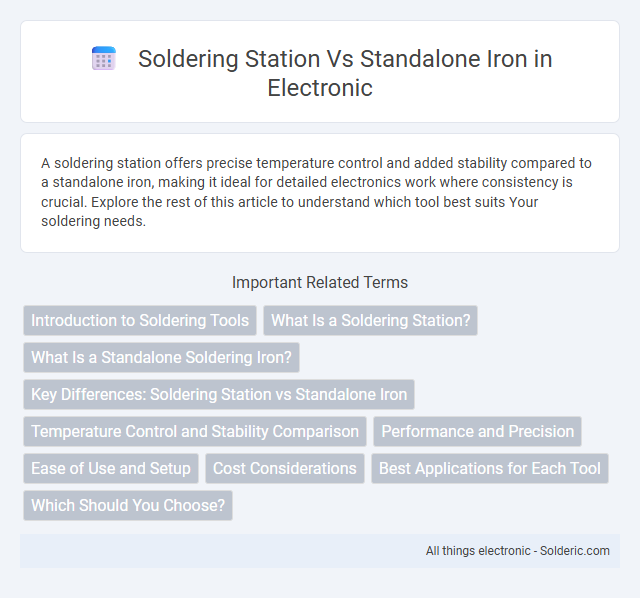A soldering station offers precise temperature control and added stability compared to a standalone iron, making it ideal for detailed electronics work where consistency is crucial. Explore the rest of this article to understand which tool best suits Your soldering needs.
Comparison Table
| Feature | Soldering Station | Standalone Iron |
|---|---|---|
| Temperature Control | Precise adjustable; digital or analog | Fixed or limited control |
| Power Output | Typically 40-80W; stable heat | Usually 30-60W; less stable |
| Heating Element | Replaceable ceramic or metal heater | Fixed heating element |
| Cost | Higher initial cost ($50 - $200+) | Lower cost ($10 - $50) |
| Portability | Less portable; requires power station | Highly portable; standalone device |
| Usage | Ideal for professional, precision work | Suitable for basic, occasional soldering |
| Accessories | Includes holder, sponge, tips | Minimal or no accessories included |
| Durability | Longer lifespan with maintenance | Shorter lifespan, less durable |
Introduction to Soldering Tools
A soldering station offers precise temperature control and consistent heat output, making it ideal for delicate electronics and professional use, whereas a standalone soldering iron lacks adjustable settings but provides portability and simplicity for quick repairs. Soldering stations typically include a power base, temperature display, and often additional features like sleep mode, enhancing user efficiency and safety. Standalone irons, being more affordable and lightweight, cater to beginners or hobbyists who need a straightforward soldering tool without advanced functionalities.
What Is a Soldering Station?
A soldering station is an integrated system consisting of a soldering iron, temperature control unit, and often a holder or stand, designed to provide precise temperature regulation for electronic soldering tasks. Unlike standalone soldering irons, which offer limited or no temperature control, soldering stations enable users to adjust heat settings for different components and solder types, improving both safety and soldering quality. This makes soldering stations ideal for professional electronics repair, assembly, and hobbyist applications requiring consistent and accurate temperature management.
What Is a Standalone Soldering Iron?
A standalone soldering iron is a compact, handheld tool designed solely for heating and melting solder without additional features or controls found in soldering stations. Unlike soldering stations, which include temperature regulation, digital displays, and interchangeable tips, standalone irons offer basic functionality, making them ideal for simple, quick soldering tasks. Your choice depends on the precision and control you need, with standalone irons suited for occasional or portable use.
Key Differences: Soldering Station vs Standalone Iron
Soldering stations offer precise temperature control and enhanced stability through integrated digital or analog systems, ideal for delicate electronics work, whereas standalone irons typically have fixed or limited temperature settings and lack advanced control features. The soldering station's ergonomic design includes interchangeable tips and a dedicated stand, improving safety and convenience compared to the simple, portable design of standalone irons. Power output generally varies, with stations delivering consistent heat levels crucial for complex tasks, while standalone irons suit basic repairs and hobbyist projects due to their simplicity and affordability.
Temperature Control and Stability Comparison
Soldering stations offer precise temperature control through built-in thermostats, ensuring consistent heat output essential for delicate electronics work. Standalone irons generally lack advanced temperature regulation, often resulting in fluctuating temperatures that can risk damage to sensitive components. Stable temperature control in soldering stations improves solder joint quality and reduces thermal stress on circuit boards.
Performance and Precision
Soldering stations typically offer superior performance and precision compared to standalone irons due to adjustable temperature control and specialized tips enabling consistent heat delivery. The integrated digital or analog settings in soldering stations ensure accurate temperature stability, reducing thermal fluctuations that can damage sensitive components. Standalone irons often lack these features, resulting in less precise solder joints and decreased overall reliability in delicate electronics work.
Ease of Use and Setup
A soldering station offers greater ease of use and setup with integrated temperature controls, a stable base, and often interchangeable tips designed for precise adjustments. Standalone irons, while portable and simpler, require additional accessories like stands, temperature controllers, and cleaning tools to achieve similar convenience and safety. Your workflow benefits significantly from the soldering station's ready-to-use design, reducing setup time and enhancing operational comfort.
Cost Considerations
Soldering stations typically have a higher initial cost due to integrated temperature control features and additional accessories, making them a worthwhile investment for frequent or precise soldering tasks. Standalone soldering irons are generally more affordable, ideal for hobbyists or occasional use but may incur higher long-term expenses from replacement tips and inconsistent temperature control. Considering efficiency and durability, soldering stations offer better cost-effectiveness over time despite their upfront price.
Best Applications for Each Tool
Soldering stations excel in precision electronics work, such as circuit board assembly and repair, offering adjustable temperature control and stability crucial for delicate components. Standalone soldering irons are ideal for general-purpose tasks like wire splicing, stained glass assembly, and simple home repairs due to their portability and ease of use. Choosing between the two depends on the complexity of the project and the need for temperature precision or mobility.
Which Should You Choose?
Choosing between a soldering station and a standalone iron depends on your project complexity and precision needs. Soldering stations offer adjustable temperature control and stability ideal for professional or frequent use, while standalone irons are more portable and suitable for quick, simple tasks. Your decision should consider factors like budget, workspace, and how often you require fine temperature regulation.
Soldering station vs standalone iron Infographic

 solderic.com
solderic.com